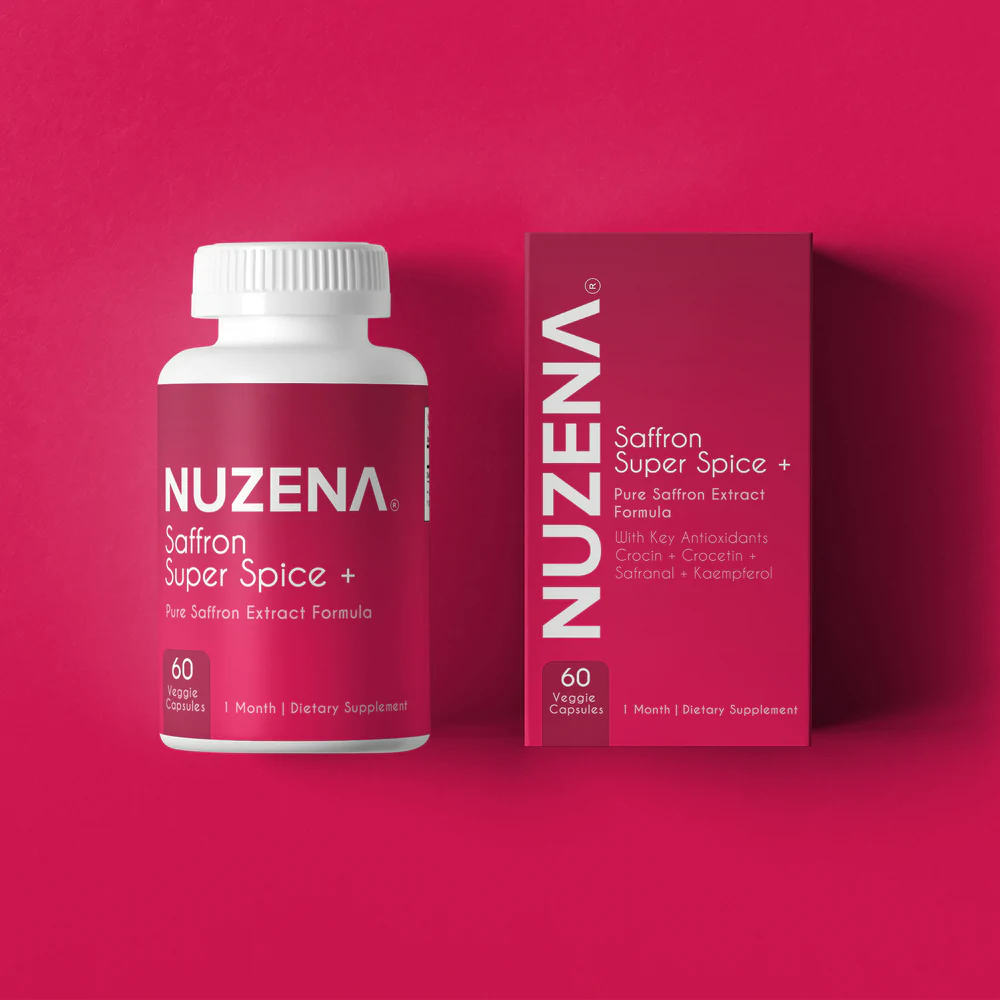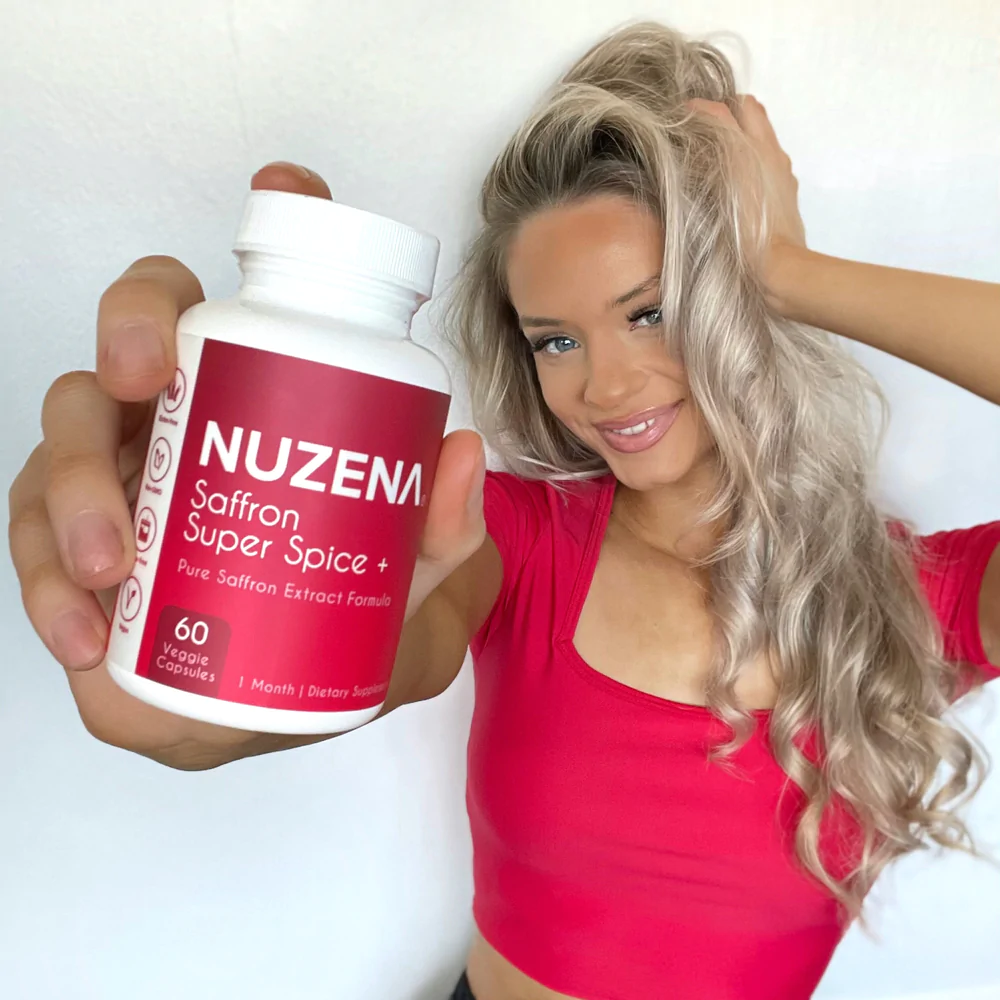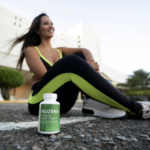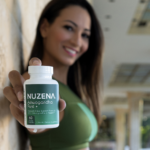
Written by Tisha Riman, Nutritionist – Reviewed by Sam Thomas, BSc Biology (Hons.)
Last updated: November 7, 2019
What is Saffron?
If you’re a fan of paella or jeweled rice, you may have already heard of the spice that presents itself as bright red threads and turns everything it touches into gold. Saffron has been a culinary staple for centuries across the globe, and for some cultures, it’s also been used for its health benefits. Ayurveda, for example, has long used saffron as a sedative, expectorant, and adaptogen. But as science moves forward, the research-based evidence has started to stack up, validating what people have known for centuries: saffron offers a lot of nutritional health benefits on top of its flavor (and beautiful coloring).(1)
13 Proven Health Benefits of Saffron
1 Saffron is a powerful antioxidant
Saffron contains a variety of plant compounds that work as antioxidants in the body. Antioxidants are molecules that fight free radical damage. What are free radicals? Free radicals are molecules that roam free in the body, and they’re the waste products of chemical processes. Free radicals, while in small doses are essential for human health (for example, our bodies use free radicals to fight off infection) (5) , can become a bigger problem when we have them in excess. In fact, free radicals are linked from everything to cancer, Alzheimer’s, heart disease and aging, amongst other human diseases. Free radical production can be promoted through our lifestyles and the environment in which we live. Things like smoking, air pollution, fried foods, high sugar intake and alcohol all contribute to oxidative stress and the formation of free radicals in the body.
This is where antioxidants come in. While our bodies do have their own antioxidants to help defend against free radicals, often, in today’s environment, it’s not enough to prevent oxidative stress (and in turn, damage to DNA). Antioxidants in food can be a great way to ensure we’re protecting our cells. The main antioxidant components in Saffron are crocin, picrocrocin, and safranal (6). Crocin and picrocrocin are responsible for giving saffron it’s deep red color, while safranal is what gives saffron its distinct color and aroma. Saffron also contains kaempferol, a flavonol molecule with antioxidant, antimicrobial and anticancer properties (7).
Crocin and picrocrocin are carotenoids–the red and orange plant pigments that serve as antioxidants (8) and research shows that they, along with other minor carotenoids in saffron (such as lycopene, carotene, and zeaxanthin) all work to reduce oxidative stress and protect the cells from damage (9). In fact, one study of 20 humans that took saffron daily for 6 weeks saw a significant improvement of protection against oxidative stress (10): lipoprotein oxidation susceptibility (LOS) decreased in both healthy individuals and those with coronary artery disease. Similarly, these antioxidant compounds have been found to protect against toxins to the body, such as aluminum (implicated in the pathogenesis of neurodegenerative diseases) and even antibiotics (11).
Summary: Saffron has antioxidant compounds in it that give its beautiful color. These compounds can help decrease oxidative stress and free radical damage to our DNA.
2 Saffron is a natural anti-inflammatory
These same antioxidant compounds are what gives saffron its anti-inflammatory effects.
Inflammation refers to the body’s ability to fight off infection, injuries and toxins. In times of injury, or when cells are damaged, the body releases antibodies and proteins to help it heal. In acute cases–like when we get a fever, an infection, or get hurt, this process is necessary and welcome. But with chronic, long-term, inflammation, the body stays in this responsive state, which can have a negative long-term impact on our overall health. In fact, inflammation has been linked to a myriad of diseases, including cancer, heart disease, rheumatoid arthritis, neurodegenerative diseases, and obesity. Research has shown that diet can play a significant role in reducing chronic inflammation, and therefore increasing our overall consumption of antioxidant-rich foods and herbs, like saffron, becomes crucial.
Crocin, in particular, was found to reduce levels of inflammatory molecules–such as TNF-alpha and interleukin-6, and reduce overall chronic inflammation (12) . Interleukin-6 is found to be higher in all diseased states and has been shown to be a predictor of midlife cognitive decline (13) –further highlighting the importance of saffron’s anti-inflammatory compounds. Because of this, and because of saffron’s ability to inhibit the inflammatory effects of certain molecules (such as syncitin-1 and nitric oxide) saffron’s anti-inflammatory properties have further-reaching benefits that can help protect the brain.
Summary: Saffron contains anti-inflammatory properties that have long reaching benefits: like preventing lifestyle related diseases and cognitive decline.
3 Saffron helps to support weight loss
We know that obesity is strongly linked to various “diseases of civilization” like diabetes, heart disease, hypertension and osteoarthritis. Part of the difficulty in losing weight is the ability to reduce overall eating and snacking. While we used to think how much we ate was a decision of free will, we now know that is largely a response to hormone function. Hormones like leptin, ghrelin, insulin and cortisol all play a large role in hunger and satiety. This explains why high levels of stress (and increased cortisol) can lead to stress-eating. Saffron may help in increasing satiety and reducing levels of cortisol, that cause us to overeat in the first place.
Research has shown that saffron may be an effective tool in curbing appetite and aiding weight loss by modifying the mechanisms of metabolic disorders. One study followed 84 patients with coronary artery disease for 8 weeks and found that saffron was able to reduce overall appetite, dietary intake and help with obesity reduction (14).
Another study looked specifically at the female population, by giving mildly overweight women a saffron extract twice daily while observing their snacking for 8 weeks. The saffron group had a significantly greater body weight reduction than the placebo group did, and the snacking frequency was significantly decreased (15).
Summary: Saffron can help increase satiety and suppress appetite, leading to weight loss and reduced feelings of hunger.
4 Saffron may help to reduce blood pressure
It’s no surprise that with saffrons anti-inflammatory compounds that it would be good for heart health (although we’re never disappointed by having the science to back it up!). It seems that saffron can also help protect the heart against heart disease and high blood pressure. High blood pressure, or hypertension, occurs when blood pressure rises to unhealthy levels. It’s usually the result of a variety of factors: genetics, environment and lifestyle choices–such as lack of physical activity and poor diet. Over the long term, this relatively silent condition can lead to heart disease, so early detection and management are essential for longevity.
In one study, rats–both hypertensive and normotensive–were given a daily oral dose of saffron over the course of five weeks. While the saffron had no effect on the rats with normal blood pressure, it did improve blood pressure in the hypertensive blood pressure (16).
Another study of 230 men with infertility found that supplementing with saffron for 26 weeks significantly reduced high blood pressure in comparison to the placebo group (17). Another study, in which 30 adults took saffron tablets daily for one week also saw reduced systolic blood pressure and mean arterial pressures (18).
Summary: Saffron’s anti-inflammatory compounds can help reduce high blood pressure.
5Saffron may help to improve health function
Expanding on what we just talked about it, saffron has been shown to be good for overall heart health, not just blood pressure! Saffron may improve heart health by increasing the pumping capacity of the heart’s ventricles. This may be due in part to the natural polyphenols kaempferol found in saffron. Research suggests that this compound may be able to reduce the risk of heart attacks, and protecting the heart from oxidative stress (19).
In fact, kaempferol has been shown to provide benefits for atherosclerosis, diabetes and coronary heart disease (20)! But it’s not the only superhero in the mix. A study on rats found that crocin, another antioxidant compound found in saffron, was able to reduce cholesterol levels and prevent atherosclerosis–hardening of the blood vessels (21). In fact, one study found that saffron was able to lower cholesterol levels by 50% (22)! Another study found that saffron had cardioprotective effects against heart attacks–again, likely due to its antioxidant properties (23).
Summary: Saffron contains antioxidant compounds that can reduce cholesterol, protect against heart attacks and prevent atherosclerosis.
6 Saffron can help to improve mood disorders
It turns out saffron may be able to brighten up your life in more ways than one–particularly in the treatment of mood disorders. Traditional Persian medicine has long been using saffron to treat depression (24) –and more and more research substantiates this. In a review of five studies, it was found that saffron was significantly more effective than placebos at alleviating symptoms of mild-to-moderate depression (25). The meta-analysis concluded that saffron supplementation could be used for improving symptoms in adults with major depressive disorder (MDD) (26).
Other studies found similar results. A six-week preliminary study that looked at postpartum depression amongst women, found that the women, aged 18-45 with mild to moderate depression saw an improvement in their depression with daily capsules of saffron (27). Research shows that saffron and its active constituents “possess antidepressant properties similar to current antidepressant medications such as fluoxetine, imipramine, and citalopram, but with fewer reported side effects (28).
It appears more studies are needed before we can be certain of the efficacy and safety of taking saffron supplementation long-term, but so far the results are promising!
Summary: While more studies are needed, saffron offers promising benefits for mental health, especially in alleviating symptoms of mild-to-moderate depression.
7 Saffron may help to improve sexual function
Speaking of mood disorders, saffron may act as an aphrodisiac–particularly amongst people with depression. A study that looked at women with major depression who struggled with fluoxetine, an antidepressant, -induced low libidos, found saffron to be a safe and effective way to improve arousal, lubrication and reduce pain (29).
But it wasn’t just women that benefited! One study looked at 36 males with major depression that suffered from fluoxetine-induced erectile dysfunction and found that the saffron group had significantly greater improved erectile dysfunction than the placebo group–with 60% returning to normal erectile function by the end of the study (30). And it’s not just men with depression either: another study followed twenty men with erectile dysfunction for ten days, in which each morning they took 200mg of saffron (31). At the end of the ten days, there was a significant improvement in sexual function!
Summary: Saffron can encourage sexual function by increasing blood flow, improving arousal and increasing lubrication.
8 Saffron can help to support symptoms of PMS
If you’ve never suffered from PMS–count yourself lucky. PMS, or premenstrual syndrome encompasses a variety of not-so-pleasant symptoms that women experience around their menstrual cycle: mood swings, breast tenderness, cramps, bloating and acne to name a few. It’s estimated that three of every four menstruating women has premenstrual syndrome. Saffron has long been used as a way to help manage symptoms and relieve menstrual pain.
In one unique study, 35 women were exposed to the odor of saffron for 20 minutes during their cycle. Cortisol levels had decreased after exposure, and estrogen increased–implying that exposure to the aroma of saffron can improve mood and help with premenstrual syndrome (32).
Another study, in which women, aged 20-45 and with PMS and regular cycles, were given either saffron twice daily or a placebo twice daily over the course of two menstrual cycles. The women in the saffron group saw a significant improvement in PMS symptoms–as much as 50%, compared with only 8% of the placebo group (33).
Summary: Saffron can alleviate symptoms of PMS by up to 50% due to its ability to affect hormones related to menstruation, like estrogen and cortisol.
9 Saffron may help to support healthy energy levels
We saw earlier that saffron was able to improve blood flow for improved heart health (and improved sexual function!) so it makes sense that it would be able to improve blood flow and get energy levels up. The same carotenoids in saffron that offer those antioxidant benefits also help to increase energy supply. One study looked at saffron’s effect on muscle strength, pulmonary function and reaction time. Twenty-eight non-active and healthy males were given either saffron or a placebo for ten days, and given a series of physical tests. The study showed that saffron significantly increased reaction times and muscle strength. This is likely due to improved mitochondrial function and increased blood flow (34).
Summary: Saffron has been shown to increase blood flow, improve reaction times and increase strength in terms of energy and athletic performance.
10 Saffron helps to support immune function
The antioxidant compounds in saffron–crocin, crocetin and safranal–have been studied for their protective effects and their anti-inflammatory activity in the body. These same compounds also contain immunoregulatory properties that play a role in boosting the immune system (35). A 2019 review on the effects of saffron on the immune system found that saffron was able to down regulate certain pro-inflammatory enzymes, such as myeloperoxidase and prostanoids. It was also to inhibit the effects of some interleukins and TNF-ɑ (36).
Summary: While more research is needed, this could mean that saffron has a powerful effect in managing and preventing immune-related disorders.
11 Saffron may improve joint & bone health
As bones become more porous and fragile, they become more at risk for fractures. This can be especially true as people age–post menopausal women in particular are at a higher for bone issues like arthritis and osteoporosis due to the role estrogen plays in bone health. Saffron may be effective in improving bone health, due to one of its constituents, crocin. One study in rats showed that daily supplementation of saffron over the course of 16 weeks prevented bone loss related to estrogen-deficiency, which could prove to be effective in protecting women from osteoporosis (37). More research is needed to expand on these claims.
Summary: Saffron may be able to reduce the risk of osteoporosis and arthritis by preventing estrogen-related bone loss.
12 Saffron may aid digestion
Earlier, we had talked about how the ancient Egyptians used to use saffron to heal gastrointestinal ailments. While research is still in its infancy, it appears that saffron can play a role in digestive health and protecting the gut lining! Saffron appears to have carminative properties (gut supportive–similar to ginger and chamomile), as well as antispasmodic properties that help the smooth muscles and alleviate bloating.
One study looked at the effects that saffron had on mice with gastric ulcers in comparison to omeprazole, a drug used for the treatment of ulcers. The study found that saffron, perhaps due to its high antioxidant levels, was effective at preventing gut mucosa damage by enriching glutathione levels (38). Another study found that saffron may be able to prevent stress- and histamine-related ulcers from happening in the first place.
Saffron may even have a role when it comes to stomach cancer: one study found that both crocin and crocetin both had anti-cancer properties that could protect against gastric cancer–although more studies are still needed.40 Another study looked at saffron in the treatment of colorectal cancer, and found that it was able to prevent the growth of tumour cells, and improve apoptosis–the body’s ability to repair and dispose of damaged cells (41).
Summary: While more research is still needed, saffron appears to have a beneficial effect on gastrointestinal health, particularly when it comes to ulcers and colon and stomach cancer.
13 Saffron may improve liver health
Another area of research when it comes to the health benefits of saffron, is its effect on liver health. Saffron appears to have protective properties in terms of liver health, most likely due to its high antioxidant and anticancer properties. The liver is an essential organ that’s responsible for over 200 vital functions, such as producing proteins, cholesterol and bile, and also for breaking down toxins like alcohol, medications and metabolic waste. In today’s environment, where we are exposed to chemicals and air pollution, it can be very easy to overwork our liver, inhibiting its natural detoxification processes. This can be compounded by a poor diet and lifestyle practices. Saffron has been shown to reduce oxidative stress and free radical damage, thanks to its antioxidant compounds.
One study on mice found that saffron was able to decrease fat deposits and decrease levels of toxic proteins in the liver (42). Another study on rats also found that saffron was able to protect the liver from drug-induced damage–again, thanks to its ability to reduce oxidative stress (43). And similar to studies done on stomach and colon cancer, saffron’s displays significant anticancer properties due to its ability to encourage apoptosis (cell death), fight inflammation and stop the growth of tumour cells (44).
Summary: Saffron’s antioxidant compounds may protect the liver from daily toxins, and inflammation.
Side Effects
1 Saffron may not be safe to take while pregnant
While studies of Saffron indicate that it is non-toxic and generally regarded as safe (GRAS) herbal ingredient, some physicians have noted that it should most likely not be consumed if pregnant.
This is possibly more of a precautionary measure than an explicit warning, based on the overwhelming evidence to suggest that Saffron is safe to consume.
There is no clinical evidence to back up the statement that Saffron is unsafe for pregnant women, however as with any treatment, whether it be natural, prescription or otherwise it is generally best to seek the advice of a doctor if you are unsure.
Summary: Overwhelming evidence suggests that Saffron is safe to consume as it is non-toxic, and is on the GRAS list (generally regarded as safe), however, pregnant women should likely avoid consuming it without the supervision of a doctor.
2 Saffron may act negatively with other medications
Saffron is effective in its use as a natural anti-inflammatory. It may not be suitable to take in conjunction with other medications, particular hormone-altering medications.
For more advice on what you can and cannot consume with Saffron is it always best to consult your doctor if you are currently on medication.
Summary: Saffron may act negatively with other medications so it is always best to consult your doctor, who knows your current prescription, and medical history.
Recommended Dosage
1Saffron dosage
In terms of supplementation, saffron can be safely tolerated up to 1.5g per day, but most studies have seen benefits with much smaller quantities–typically at 30mg daily–so larger doses do not seem to be required.
Saffron supplements should be taken twice daily, in doses ranging from 30mg-50mg for up to six weeks.
While there are most certainly outliers to the above ranges, in which some patients achieved the desired effect with less or more, over a shorter or longer period, these appear to be the most representative of the studies examined.
Summary: The recommended Saffron dosage to see the noticeable physiological benefit is between 30mg-50mg total daily, with the duration of consuming it ranging being 60-90 days.
How To Use Saffron
1Make saffron part of your daily routine
If you’re looking to include saffron in your diet, but don’t want to supplement, consider adding saffron to your favourite meals! Saffron has a long history for its culinary purposes and can be a great base for delicious and healthy meals. And while you may only think of it as a spice you can use for dinner, consider the possibilities of adding it to your morning dishes!
Add saffron to:
- Risottos and rice dishes
- Chicken or fish marinades
- Chia pudding
- Oatmeal
- Soups
- Cauliflower rice
Be creative! There are lots of different ways to include saffron as part of your diet. Add it to dishes you already know and love, or use it as an excuse to expand on your culinary repertoire!
Final Thoughts on Saffron
1Saffron summary
The research on saffron is still new, but we know that saffron shows a lot of promise and the evidence is already stacking up to show us that it offers a variety of health benefits ranging from heart health to longevity. It’s considered relatively safe to supplement, and has long been used for culinary purposes. Saffron’s long history of being considered a treasure is for good reason! It’s a powerful spice and antioxidant. The science shows that it can improve mood, reduce blood pressure, improve PMS, aid in weight loss and reduce oxidative stress. Definitely all things we want in our modern society! Saffron is proving without a doubt, that it’s an oldie, but a goodie.
References
- Leffingwell JC. saffron. Leffingwell Reports. 2002;2:1–6. [Google Scholar] [Ref list]
- Ghorbani, M. (2008), “The Efficiency of Saffron’s Marketing Channel in Iran” (PDF), World Applied Sciences Journal, 4 (4), pp. 523–527, ISSN 1818-4952, retrieved 3 October 2011
- Honan, W. H. (2 March 2004). “Researchers Rewrite First Chapter for the History of Medicine”. The New York Times. Retrieved 13 September 2011.
- Willard, P. (2002), Secrets of Saffron: The Vagabond Life of the World’s Most Seductive Spice, Beacon Press, ISBN 978-0-8070-5009-5
- https://www.ncbi.nlm.nih.gov/pubmed/9787133
- Avicenna J Phytomed. 2015 Sep-Oct;5(5):376-91.The effects of Crocus sativus (saffron) and its constituents on nervous system: A review
- https://www.ncbi.nlm.nih.gov/pubmed/10552777
- https://www.ncbi.nlm.nih.gov/pmc/articles/PMC4375186/
- https://www.ncbi.nlm.nih.gov/pmc/articles/PMC4375186/
- https://www.ncbi.nlm.nih.gov/pubmed/9808914
- https://www.ncbi.nlm.nih.gov/pmc/articles/PMC4418072/
- https://pdfs.semanticscholar.org/f487/b3e6323ce88fbb88820416ab1aca5cd9d2c9.pdf
- https://www.ncbi.nlm.nih.gov/pubmed/24991031
- https://www.ncbi.nlm.nih.gov/pubmed/29391933
- https://www.ncbi.nlm.nih.gov/pubmed/20579522
- https://www.ncbi.nlm.nih.gov/pmc/articles/PMC4764118/
- https://www.ncbi.nlm.nih.gov/pubmed/20824894
- https://www.ncbi.nlm.nih.gov/pubmed/18693099
- https://www.ncbi.nlm.nih.gov/pubmed/28219095
- https://www.ncbi.nlm.nih.gov/pubmed/28219095
- https://www.ncbi.nlm.nih.gov/pubmed/16828739/
- https://www.ncbi.nlm.nih.gov/pubmed/23074606/
- https://www.ncbi.nlm.nih.gov/pubmed/23638293
- https://www.ncbi.nlm.nih.gov/pubmed/15707766
- https://www.ncbi.nlm.nih.gov/pubmed/24299602
- https://www.ncbi.nlm.nih.gov/pubmed/24299602
- https://www.ncbi.nlm.nih.gov/pubmed/27595298
- https://www.ncbi.nlm.nih.gov/pubmed/29136602
- https://www.ncbi.nlm.nih.gov/pubmed/23280545
- https://www.ncbi.nlm.nih.gov/pubmed/22552758
- https://www.ncbi.nlm.nih.gov/pubmed/19427775
- https://www.ncbi.nlm.nih.gov/pubmed/21242071
- https://www.ncbi.nlm.nih.gov/pubmed/18271889
- https://www.ncbi.nlm.nih.gov/pubmed/26811090
- https://www.ncbi.nlm.nih.gov/pmc/articles/PMC6535192/
- https://www.ncbi.nlm.nih.gov/pmc/articles/PMC6535192/
- https://www.ncbi.nlm.nih.gov/pmc/articles/PMC4150429/
- https://www.ncbi.nlm.nih.gov/pmc/articles/PMC4923465/
- Pharmacological properties of N-095, a drug containing red ginseng, polygala root, saffron, antelope horn and aloe wood. Inoue E, Shimizu Y, Shoji M, Tsuchida H, Sano Y, Ito C
- Am J Chin Med. 2005; 33(1):49-60.
- Crocin triggers the apoptosis through increasing the Bax/Bcl-2 ratio and caspase activation in human gastric adenocarcinoma, AGS,
- Hoshyar R, Bathaie SZ, Sadeghizadeh M DNA Cell Biol. 2013 Feb; 32(2):50-7.
- The anticancer effect of saffron in two p53 isogenic colorectal cancer cell lines.
- Bajbouj K, Schulze-Luehrmann J, Diermeier S, Amin A, Schneider-Stock R BMC Complement Altern Med. 2012 May 28; 12():69.
- https://www.ncbi.nlm.nih.gov/pmc/articles/PMC4418072/
- https://www.ncbi.nlm.nih.gov/pmc/articles/PMC4224710/
- Amr Amin, Alaaeldin A. Hamza, Khuloud Bajbouj, S. Salman Ashraf, Sayel Daoud. Saffron: A potential candidate for a novel anticancer drug against hepatocellular carcinoma. Hepatology, 2011; DOI: 1002/hep.24433

















